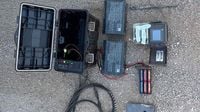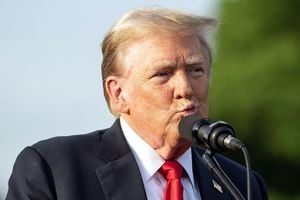In the fraught landscape of southern Lebanon, the cycle of conflict and fragile ceasefires between Israel and Hezbollah has taken a dramatic turn in recent days, with each side trading blows and political overtures amid international scrutiny. The latest developments have brought renewed attention to the persistent tensions along the Lebanese-Israeli border and the wider implications for regional stability.
On Friday, August 29, 2025, the Israel Defense Forces (IDF) announced a targeted strike that killed Ahmad Naeem Maatouk, a battalion staff commander in Hezbollah’s elite Radwan Force, just north of the Litani River in the area of Sir El Gharbiyeh, southern Lebanon. According to the IDF, Maatouk was deeply involved in planning and executing attacks against Israel during the ongoing war, which has seen intermittent flare-ups despite multiple ceasefire attempts. The military described his actions as a “violation of the understandings between Israel and Lebanon,” as reported by the Jerusalem Post.
This was not an isolated incident. Just a day earlier, Israeli Air Force aircraft struck several Hezbollah targets in southern Lebanon, including a rocket launcher. And on Tuesday, August 26, the IDF killed another Hezbollah operative in Tebnine, east of Tyre, who was reportedly working to rebuild Hezbollah infrastructure in the border town of Beit Lif. These operations underscore the IDF’s ongoing campaign against what it considers a persistent threat on its northern frontier. Israeli officials have made it clear that their troops will remain in five strategic positions in southern Lebanon until the Lebanese army is able to maintain security in those areas.
The military exchanges come at a time when diplomatic efforts are intensifying. Prime Minister Benjamin Netanyahu stated on Monday, August 25, that Israel stands ready to support Lebanon in its efforts to disarm Hezbollah and work toward a secure future for both nations. Netanyahu hailed as a “momentous decision” Beirut’s approval—across two Cabinet sessions on August 5 and 7—of a U.S.-backed plan directing the Lebanese Armed Forces to begin disarming Hezbollah and all other non-state actors by the end of 2025. “Israel stands ready to support Lebanon in its efforts to disarm Hezbollah and work toward a secure future for both nations,” Netanyahu said, according to The Times of Israel.
On the American side, U.S. envoy Thomas Barrack indicated on Tuesday, August 26, that the Lebanese government is expected to present a proposal on August 31 aimed at persuading Hezbollah to disarm without the use of force. Barrack added that Israel is expected to develop its own framework for an IDF withdrawal from southern Lebanon once Lebanon announces its strategy, as reported by Reuters.
U.S. lawmakers have also weighed in. Senators Jeanne Shaheen (D-N.H.) and Lindsey Graham (R-S.C.) recently led a bipartisan delegation to Lebanon, pressing for Hezbollah’s disarmament and stronger U.S.-Lebanon ties. “One of the keys to managing that reality is the full disarmament of Hezbollah,” Shaheen said on August 26, emphasizing the need to support Lebanon’s bold decisions, strengthen the Lebanese Armed Forces, and advance financial reforms for the country’s future. Representative Joe Wilson (R-S.C.) joined the delegation, reflecting the bipartisan consensus in Washington on the issue.
Meanwhile, on the ground in Lebanon, the situation remains volatile. On Saturday, August 30, Lebanese government forces dismantled what they described as an Israeli spying device in the southern province of Nabatieh, close to the border with Israeli-occupied territories. The Lebanese Army said in a statement that a specialized unit discovered espionage equipment with a hidden camera during an engineering survey on the outskirts of Yaroun. The military urged residents to avoid suspicious objects and to report them immediately to the nearest military post for their own safety, according to Al Jazeera.
This discovery comes amid ongoing accusations from Lebanon that Israel has violated the terms of previous ceasefires. After suffering significant losses over nearly 14 months of war, Israel agreed to a ceasefire with Hezbollah that took effect on November 27, 2024. However, hostilities have continued sporadically. Lebanon announced an extension of the ceasefire on January 27, 2025, until February 18, but Israeli forces have maintained their occupation of five key regions in southern Lebanon: Labbouneh, Mount Blat, Owayda Hill, Aaziyyeh, and Hammamis Hill—all close to the border. Lebanese officials have condemned this continued military presence as a breach of the ceasefire agreement and the established timeline for withdrawal. Senior officials in Beirut have pledged to take “all necessary measures” to remove the occupying Israeli troops, as reported by Press TV.
The roots of the current hostilities stretch back to October 7, 2023, when Hezbollah began attacking Israel in the wake of the Hamas-led massacre in southern Israel. The resulting war dragged on for over a year, with a ceasefire finally brokered in late November 2024. While most IDF ground forces have since withdrawn, Israel’s continued hold on strategic positions in southern Lebanon remains a sticking point in negotiations and a source of tension on the ground.
The Lebanese government’s recent Cabinet approval of a U.S.-backed plan to disarm Hezbollah and other non-state actors by the end of 2025 has been hailed by some as a turning point. Yet, the path forward is far from clear. Hezbollah’s deep entrenchment in southern Lebanon, its significant military capabilities, and the group’s longstanding resistance to disarmament complicate the implementation of any such plan. The group’s ties to Iran further muddy the waters, with Tehran’s influence looming large over any efforts to reduce Hezbollah’s power.
International actors remain divided on the best approach. While U.S. officials and many in the Israeli government support a negotiated disarmament process, some Lebanese factions view these external pressures with suspicion, fearing a loss of sovereignty or a destabilization of the delicate political balance within Lebanon. The Lebanese Armed Forces, for their part, face the daunting challenge of asserting control in regions where Hezbollah has long operated as both a political and military force.
As the August 31 deadline approaches for Lebanon to present its proposal to persuade Hezbollah to disarm, all eyes are on Beirut and Jerusalem. The outcome of these deliberations could set the tone for the region’s security architecture for years to come. Will the Lebanese government succeed in convincing Hezbollah to lay down its arms peacefully, or will the cycle of violence continue to overshadow hopes for a durable peace?
For now, the border remains tense, with both sides watching and waiting. The coming weeks will be critical in determining whether diplomacy can prevail over the entrenched dynamics of conflict—or whether southern Lebanon will once again become the flashpoint for a wider regional escalation.




